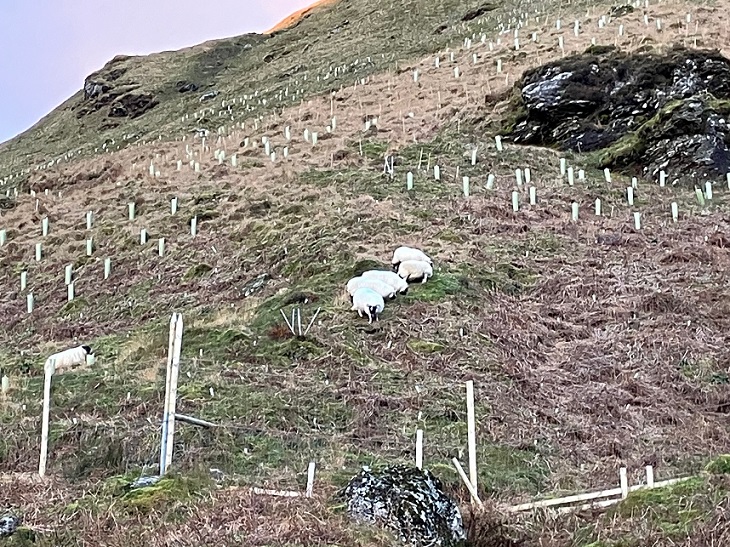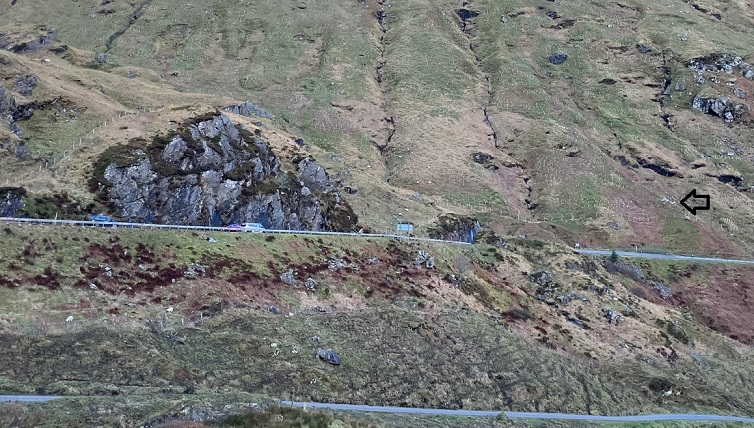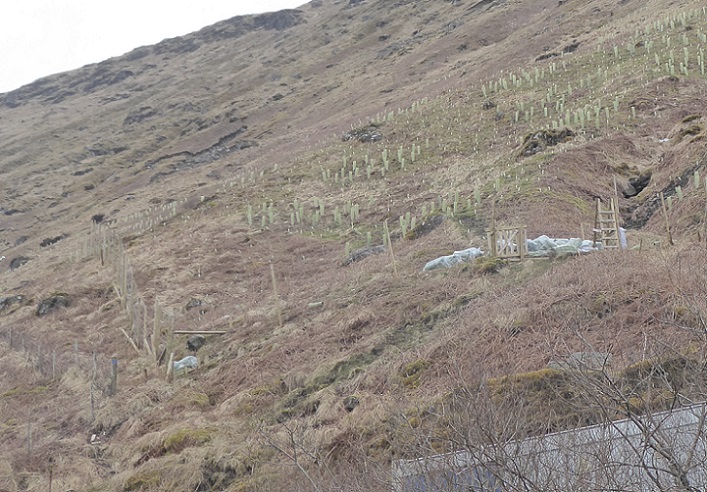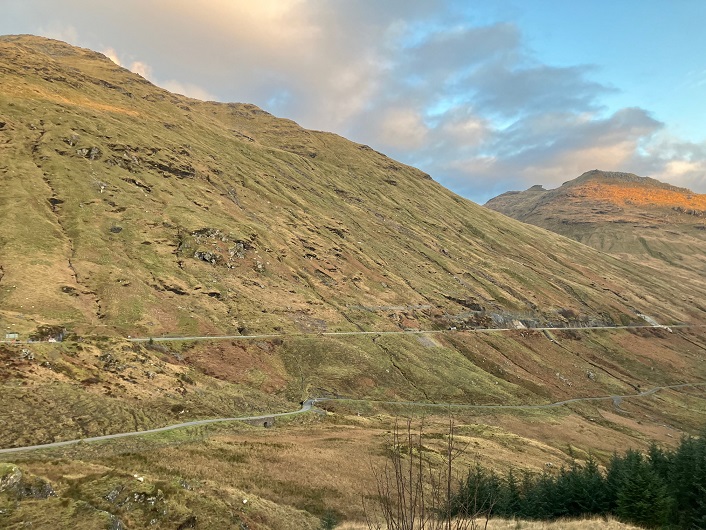
Having written fairly extensively about the impact of grazing on landslips, earlier this week I was alerted that sheep had got into the new native wood plantation intended to help stabilise the slopes above the A83 at the Rest and Be Thankful. I contacted Nick Halls, a contributor to Parkswatch, who by chance was returning to Cowal and took a number of photographs.
The head of left-hand sheep in the photo appears to be directly above on the the plastic vole guards and it was no doubt enjoying the taste of one of the newly planted trees protruding from it. Note too the number of wooden stakes used to support saplings, some of which are no longer surrounded by tubes and appear to have lost their trees. Judging by the angle of some of the stakes, it appears the sheep may have knocked over some of the shelters to browse at the trees. What a disaster!

In 2012 Transport Scotland’s Transport Research Laboratory published an excellent report by Professor Mike Winter and A Corby on ecological restoration options at the Rest and Be Thankful (see here). It included this conclusion and recommendation:
“Issues related to the potential for livestock to aid or detract from stability are discussed. It is considered that livestock have a negative effect on stability. They will also have a detrimental effect upon recently planted vegetation. It is recommended that if a planting scheme is undertaken then livestock, including deer, should be excluded from the planted area and the wider hillside area”.
Scottish Ministers take note! It has taken ten years for the Scottish Government, acting through Forest and Land Scotland (FLS), to acquire, fence and start planting the slopes above the A83 at the Rest and Be Thankful, during which period sheep were allowed to continue to graze the slopes (see here). No sooner has the planting been completed than the sheep are back in. There could not be a better example of complete system failure.

Sheep are surprisingly nimble, are capable of jumping some stock fences and because of the very steep and rocky slope may have found somewhere to jump the deer fence. Alternatively, they may have got into the enclosure through a gate:

When the fence was first planned there were no deer recorded on the slopes of the Rest and Be Thankful because there were so many sheep (sheep tend to displace deer). The justification for erecting a deer fence before planting trees was that if the sheep were removed from the slope deer were likely to move in from elsewhere. While this could and should have been controlled by stalking, there was an argument that it was so important to get trees established that FLS couldn’t afford to lose any to deer browsing. However legitimate that argument might have sounded originally, it now lies in tatters.
The sheep incursions at the Rest and Be Thankful provide an excellent illustration of the fact that deer fences are of very limited use. If sheep can get through or over a fence so easily, think how much easier it is for that athletic species, the red deer. The deer fence at the Rest and Be Thankful, like such fences elsewhere, has been a complete waste of public money.
Moreover, if there had been no fence, instead of wasting four years planning it, FLS could have started planting the Rest and Be Thankful as soon as it had purchased the property.

For fence-free planting to work, however, would have required FLS to employ a local forester/stalker whose job would be to monitor the property, which extends over the summit of Beinn Luibhean to Ben Ime and beyond, and cull any deer that moved in. This is effectively what happens now in some of the Cairngorms Connect area – FLS are one of the partners – and the conservation side of Mar Lodge Estate. So why doesn’t FLS learn from that?
To protect the newly planted trees year round would require a license from NatureScot to shoot deer out of the stalking seasons (until such time as these are reformed): however, given the national interest, the granting of such a license should be straightforward.
A local forester could also respond promptly to any incursions by sheep but here the law also needs to be changed. Farmers need to be made legally responsible for controlling their sheep whether through active shepherding, as happens on the continent, or fencing. Instead of paying foresters to fence sheep out, the Scottish Government should also use the rural payments system to ensure farmers fence sheep in and any that don’t, as in Glen Croe, should lose their agricultural subsidies.
In the Middle Ages the damaging impact of “straying” sheep was well recognised and in some English villages you can still see sheep pounds, small wall enclosures where stray sheep were taken until the owner paid the appropriate fine. We have no such controls now, even when sheep enter protected areas of Caledonian Pine Forest (see here). The law is totally biased towards agricultural interests: farmers have a right to shoot stray dogs but foresters have no right to shoot stray sheep.
The Scottish Government has an opportunity to change all this in the Agriculture and Rural Communities Bill.

On his way down Glen Kinglas from the Rest and Be Thankful, Nick Halls stopped to take another look at the landslips there, land where he had also spotted sheep recently (see here). No sheep were evident but the positive impact that even small groups of trees can have on landslips was clearly visible. Nick noted how the birch had held back the bigger material and only the finer material had reached the road (see next photo). His conclusion was that “natural regeneration of birch trees, might protect infrastructure, store carbon, contribute to bio diversity……………”.
After Vicky Allan first wrote about the potential for ecological restoration to reduce the landslips at the Rest and Be Thankful (see here), she was contacted by Ron Greer and Derek Pretswell about proposals they had presented to the then Transport Secretary, Keith Brown, in 2014. Vicky Allan then wrote another excellent article for the Sunday Herald (see here) about their ideas on the potential for bio-engineering at the Rest and Be Thankful. It is highly recommended reading but unfortunately most of the ideas they proposed have been completely ignored by Forest and Land Scotland.

Ron and Derek proposed that the planting should start with willow along the banks of watercourses. While landslips can occur on a variety of slopes, many of those at the Rest and Be Thankful and in Glen Kinglass are associated with watercourses. Intense rainfall flows into these channels and then destroys the banks, as you can see from this photo, releasiing large quantities of silt which in this case has been swept through the trees and across the road.
. Planting suckering species like willow would help reinforce and stabilise the banks and then other suckering species, like aspen, could do the same for other areas. That work could start now if the Scottish Government switched the money they are forking out through the forestry grants system to plant trees on peat to slope stabilisation work.
What needs to happen
The Scottish Minister responsible for our failed farming and forestry system, as documented in this post, is the Cabinet Secretary for Rural Affairs, Mairi Gougeon. She, more than anyone in government, is in a position to mitigate Scotland’s landslip problem through measures which sound simple but would require her to take on various vested interests for the wider public good. Those measures should include:
- the re-direction of public money currently spent on deer fencing toward employing stalkers to enable trees to grow without the protection of fences or tree tubes;
- the redirection of forestry grant from planting on peat to planting trees to reduce landslip risks;
- the devolution of forest management and reinstatement of local foresters who are able to respond to problems on the ground as they occur;
- trialling different methods of “bio-engineering” on unstable slopes to establish what works best;
- the creation of new mechanisms to ensure that farmers keep sheep and livestock under proper control and do not stray onto other land;
- ending all subsidies for livestock grazing on slopes at risk of landslips.
With a number of land-use bill about to go through the Scottish Parliament there are plenty of opportunities for the Scottish Government to enact and implement the measures suggested here as part of Scotland’s response to the climate and nature emergencies.
Our National Parks, of course, should have been at the forefront of calling for and trialling measures such as those proposed here, but where are they? A good start would be if Mairi Gougeon asked Lorna Slater what she is going to do to ensure the Loch Lomond and Trossachs National Park Authority stops sitting on its hands at the Rest and Be Thankful as it has done for 20 years.

A valiant attempt to get through to the various public bodies and the Scottish Government how they should be reversing the multiple failures of them all over the last 10 years and more on the Rest & Be Thankful which has resulted in the regular disruption of one of Scotland’s main trunk roads and has cost millions in wasted taxpayers’ money. As this blog shows even when they appear to be listening and learning from their failures, these bodies make another series of mistakes in the tree planting implementation.
I suppose we must keep trying, but our Scottish Government culture which pervades all of its public bodies is all about covering up the mistakes. Although trivial in the big scheme of things, the Michael Matheson debacle is a clear demonstration of this nasty culture endemic within our Scottish Government and its associated public bodies.
So I take a poor farmer ripped all the trees from the rest and be thankfull so his sheep can graze on the land . If the stumps were left in place the soil stability would have been left intact.
Sorry for the delay in approving, I have been away. The south facing slope of Beinn Luibhean where the landslips that close the road occur is the largest section along Glen Croe that has never been planted. Planting trees does not stop landslips as I have shown in other posts.
Sorry for the delay in approving, I have been away. The south facing slope of Beinn Luibhean where the landslips that close the road occur is the largest section along Glen Croe that has never been planted. Planting trees does not stop landslips as I have shown in other posts.